Dependencies¶
Principle¶
Dependencies are used to satisfy two main requirements :
Limit the sending of notifications
Target the alerts
The dependencies of objects are of two types:
Physical dependencies between objects: a load balancing switch is situated upstream of a set of servers and downstream of a router
Logical dependencies between objects: the access to a website with authentication LDAP depends on the status of the LDAP directory itself
Physical dependencies¶
Physical dependencies consist of taking into account physical links between equipment. This link can only be defined for objects of the “Host” type.
The configuration of a physical dependencies takes place in the Relations tab of a configuration sheet of a host (Configuration > Hosts > Add).
It is possible of define two settings:
Parent hosts: signifies that the hosts selected are parents of this host (situated upstream). If all the parent hosts selected become unavailable or impossible to reach the host itself will be considered by the scheduler as impossible to reach.
Child hosts: signifies that the host becomes the parent of all the child hosts selected.
It is not possible to have dependencies between hosts from different pollers.
Note
All the parents of a host must be in a Not-OK status for the host itself to be considered impossible to reach. If only one access path is down (physical dependencies link), the scheduler will continue to monitor this host.
Logical dependencies¶
Logical dependencies consist of installing logical links between multiple objects that may or not be of different types. E.g.: a service is in charge of supervising the access to a web page requiring an authentication based on a LDAP. It is logical that if the LDAP server is down, the access to the web page will be difficult or even impossible. In this situation, the notification issued should only be communicated to the LDAP directory and not to the website.
Hosts¶
To configure a logical dependencies:
Go into the menu: Configuration > Notifications
In the left menu, under the title: Dependencies, click on Hosts
Click on Add
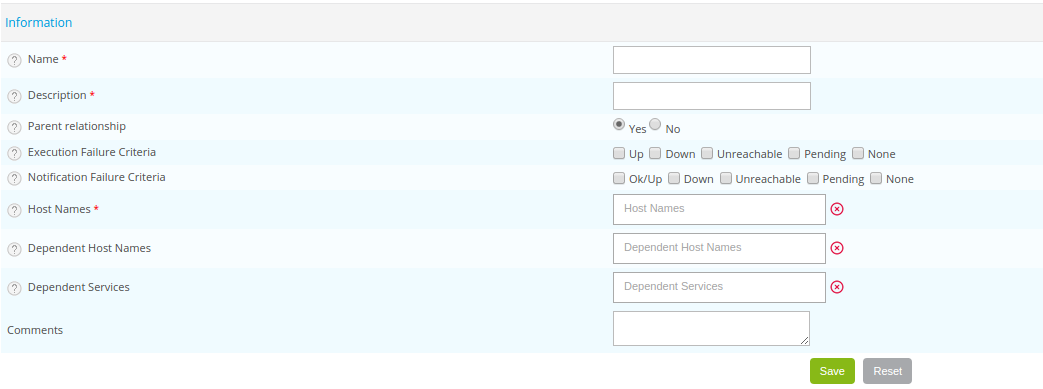
In this case, we have two types of host that come into play: one or more hosts (called master hosts) of which the status controls the execution and notification of other hosts (called dependent hosts). If you use the Centreon Broker, it is also possible to control the execution and notification of services (called dependent services) from master hosts.
The Name and Description fields indicate the name and the description of the dependencies
The Parent relationship field should be ignored if you use the Centreon Engine. If it is enabled, and if the dependencies links of the master host become unavailable, the dependencies in the process of creation is not taken into account.
The Execution Failure Criteria field indicates the statuses of the master host(s) preventing the check of the hosts or the dependent services
The Notification Failure Criteria field indicates the statuses of the master host(s) preventing the sending of notifications to the hosts or the dependent services
The Hostnames list defines the master host(s)
The Dependent Host Names list defines the dependent hosts
The Dependent Services list defines the dependent services
The Comments field can be used to comment on the dependencies
Services¶
To add a dependencies at the services level:
Go into the menu: Configuration > Notifications
In the left menu, under the title: Dependencies, click on Services
Click on Add
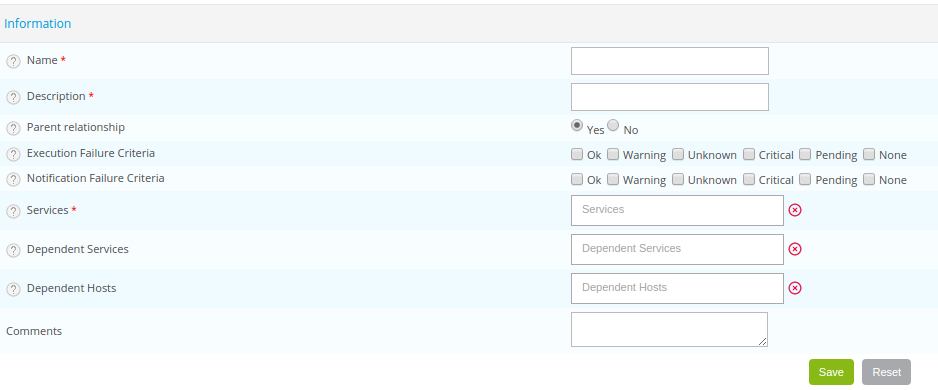
In this case, we have two entities that come into play: the (“master”) services which control the execution and the notification of other (“dependent”) services. If you use Centreon Broker, it is also possible of control the execution and the notification of other hosts.
The Name and Description fields indicate the name and description of the dependencies
The Parent relationship field should be ignored if you use the Centreon Engine. If it is enabled, and if the links of dependencies of the master service become unavailable the dependencies in the process of creation is no longer taken into account.
The Execution Failure Criteria field indicates the statuses of the master service(s) preventing the check of the hosts or the dependent services
The Notification Failure Criteria field indicates the statuses of the master service(s) preventing the sending of notifications to the hosts or the dependent services
The Services list defines the master service(s)
The Dependent services list defines the dependent services
The Dependent hosts list defines the dependent hosts
The Comments field can be used to comment on the dependencies
Host groups¶
To add a dependencies at the host groups level:
Go into the menu: Configuration > Notifications
In the left menu, under the title: Dependencies, click on Host Groups
Click on Add
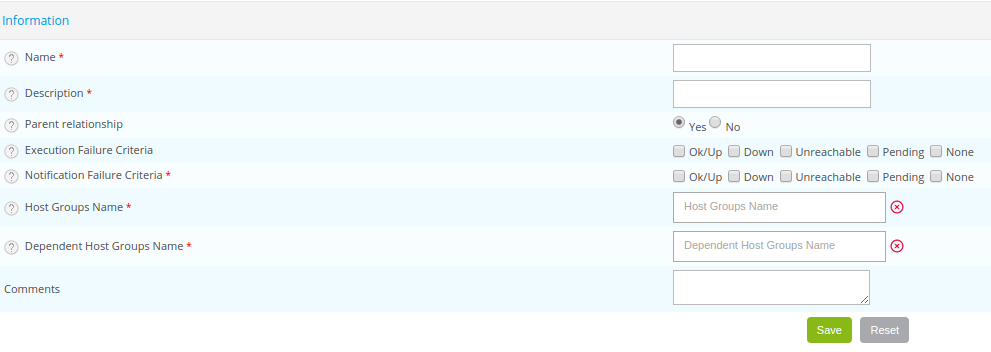
Two types of host groups: a host group is called a master if it controls the execution and the notification of other (“dependent”) host groups.
The Name and Description fields indicate the name and the description of the dependencies
The Parent relationship field should be ignored if you use the Centreon Engine. If it is enabled, and if the links of dependencies of the master host group become unavailable the dependencies in the process of creation is no longer taken into account.
The Execution Failure Criteria field indicates the statuses of the master host group(s) preventing the check of the dependent host groups
The Notification Failure Criteria field indicates the statuses of the master host(s) preventing the sending of notifications to the dependent host groups
The Host groups name list defines the master host group(s)
The Dependent host group name list defines the dependent host group(s)
The Comments field can be used to comment on the dependencies
Service groups¶
To add a dependencies at the service groups level:
Go into the menu: Configuration > Notifications
In the left menu, under the title: Dependencies, click on Service Groups
Click on Add
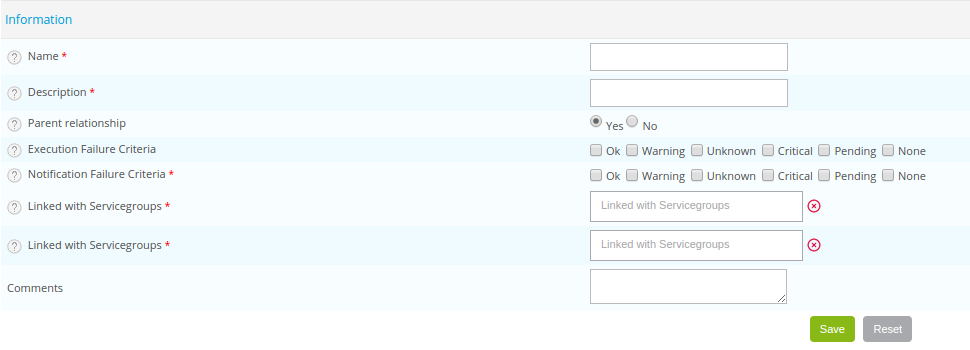
Two types of service group: a service group is called a “master” if it controls the execution and the notification of other (“dependent”) service groups.
The Name and Description fields indicate the name and the description of the dependencies
The Parent relationship field should be ignored if you use the Centreon Engine. If it is enabled, and if the links of dependencies of the master service group become unavailable the dependencies in the process of creation is no longer taken into account.
The Execution Failure Criteria field indicates the statuses of the master service group(s) preventing the check of the dependent service groups
The Notification Failure Criteria field indicates the statuses of the master host(s) preventing the sending of notifications to the dependent service groups
The Service group names list defines the group(s) of master services
The Dependent service group names list defines the group(s) of dependent services
The Comments field can be used to comment on the dependencies
Meta-services¶
To add a dependencies at the meta-services level:
Go into the menu: Configuration > Notifications
In the left menu, under the title: Dependencies, click on Meta Services
Click on Add
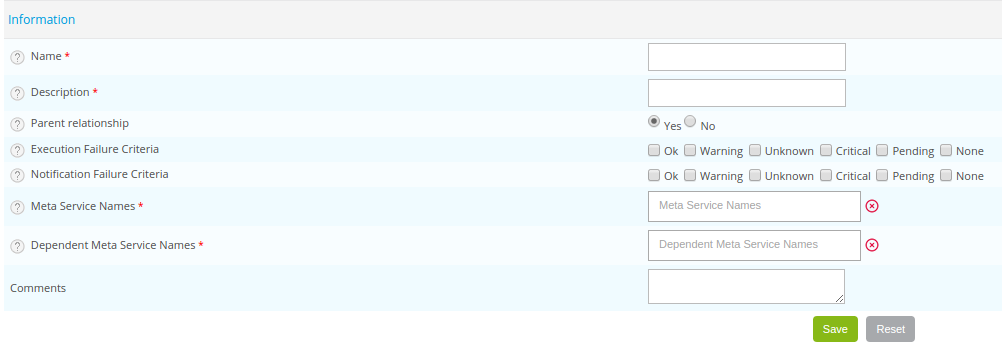
Two types of meta-services: a meta-service is called a “master” if it controls the execution and the notification of other (“dependent”) meta-services.
The Name and Description fields indicate the name and description of the dependencies
The Parent relationship field should be ignored if you use the Centreon Engine. If it is enabled, and if the links of dependencies of the master meta-service become unavailable the dependencies in the process of creation is no longer taken into account.
The Execution Failure Criteria field Indicates which are the statuses of the meta-master service(s) that will prevent the check of the meta-dependent services
The Notification Failure Criteria field indicates the statuses of the meta-service(s) preventing the sending of notifications to meta-dependent services
The Meta-service name list defines the master meta-service(s)
The Dependent meta-service names list defines the dependent meta-service(s)
The Comments field can be used to comment on the dependencies